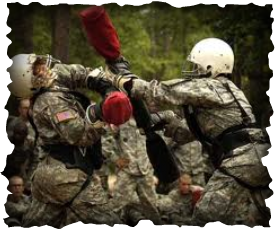Army Basic Training

United States Army Basic Training is a rigorous program of physical and mental training required in order for an individual to become a soldier in the United States Army, United States Army Reserve, or Army National Guard. It is carried out at several different Army posts around the United States. Basic Training is designed to be highly intense and challenging. The challenge comes as much from the difficulty of physical training as it does from the required quick psychological adjustment to an unfamiliar way of life.
Basic Training is divided into two parts: Basic Combat Training and Advanced Individual Training.
Basic Combat Training, or BCT, consists of the first ten weeks of the total Basic Training period. It is identical for all Army, Army Reserve, and Army National Guard recruits. This is where individuals learn about the fundamentals of being a soldier, from combat techniques to the proper way to address a superior. BCT is also where individuals undergo rigorous physical training, to prepare their bodies for the eventual physical strain of combat. One of the hardest and most essential lessons learned in BCT, however, is self-discipline: BCT introduces prospective soldiers to a strict daily schedule, entailing many duties and extremely high expectations for which most civilians are not immediately ready.
Advanced Individual Training (AIT), consists of the remainder of the total Basic Training period. It is where recruits train to eventually become experts in their chosen field, and it is therefore different for each available Army career path. Such AIT courses last from 6 to 52 weeks. For example, if an individual has an MOS (Military Occupational Specialty) of Human Intelligence Collector, they would be sent, following completion of BCT, to the Intelligence School at Fort Huachuca, Arizona. If an individual instead had the MOS of Army medic, they would be sent, after BCT, to the Army Medical Department School at Fort Sam Houston, Texas. Although many AIT schools don't center around combat the way BCT does, individuals are still subject to the same duties, strict daily schedule, and disciplinary rules as in BCT. AIT trainees are also continually tested for physical fitness and weapons proficiency
Basic Training is divided into two parts: Basic Combat Training and Advanced Individual Training.
Basic Combat Training, or BCT, consists of the first ten weeks of the total Basic Training period. It is identical for all Army, Army Reserve, and Army National Guard recruits. This is where individuals learn about the fundamentals of being a soldier, from combat techniques to the proper way to address a superior. BCT is also where individuals undergo rigorous physical training, to prepare their bodies for the eventual physical strain of combat. One of the hardest and most essential lessons learned in BCT, however, is self-discipline: BCT introduces prospective soldiers to a strict daily schedule, entailing many duties and extremely high expectations for which most civilians are not immediately ready.
Advanced Individual Training (AIT), consists of the remainder of the total Basic Training period. It is where recruits train to eventually become experts in their chosen field, and it is therefore different for each available Army career path. Such AIT courses last from 6 to 52 weeks. For example, if an individual has an MOS (Military Occupational Specialty) of Human Intelligence Collector, they would be sent, following completion of BCT, to the Intelligence School at Fort Huachuca, Arizona. If an individual instead had the MOS of Army medic, they would be sent, after BCT, to the Army Medical Department School at Fort Sam Houston, Texas. Although many AIT schools don't center around combat the way BCT does, individuals are still subject to the same duties, strict daily schedule, and disciplinary rules as in BCT. AIT trainees are also continually tested for physical fitness and weapons proficiency
